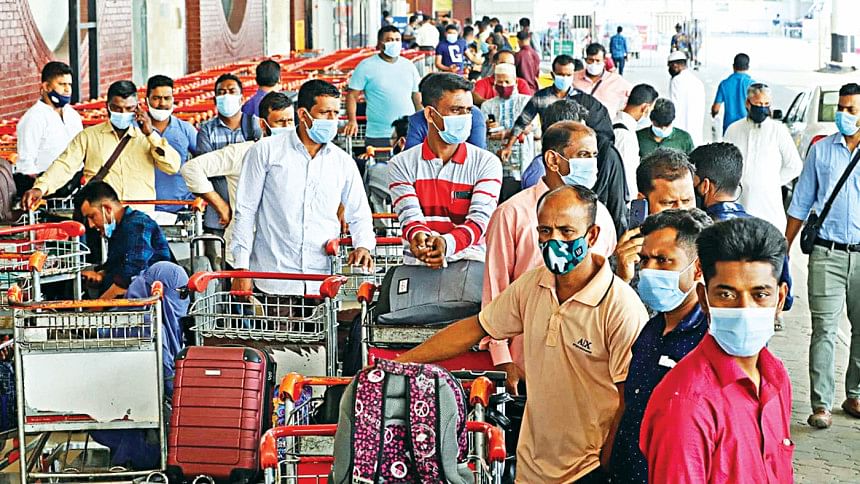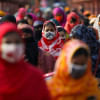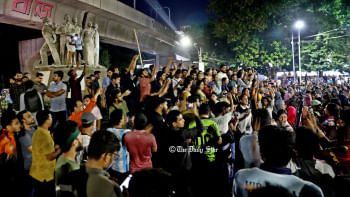Migration can boost recovery, growth and resilience across South Asia

Migration worldwide happens for two main reasons, both central to economic development. First, people migrate to seek better jobs and move to where they are more productive. Second, people migrate to cope with local economic shocks, such as weather-related disasters that continue to strike South Asia at a resounding pace.
Take the case of Mohamed, who left his native Pakistan to start a job in the construction sector in Qatar, a country that has traditionally been the destination for thousands of migrants in search for a better life. Mohamed eventually switched jobs to the transportation sector and finally settled in catering services, all along supporting his family back home via remittances, hoping the money pays for basic food and helps lift his family out of poverty, and some day, even enables him to buy a home.
Like millions of other migrants from South Asia to the Gulf, Mohamed earned 3-5 times more as a migrant worker than what he would have in Pakistan. However, like many of his counterparts in South Asia, Mohamed paid the equivalent of US$3000—2.5 years of his home income—to migrate to Qatar. The tight existence of Mohamed represents the grueling life of thousands of South Asian migrants—mostly men—who pay significant sums to migrate internationally, taking on mostly manual labour jobs and increasing their earnings for a couple of years before returning to their home country.
However, the COVID-19 pandemic hit livelihoods of migrants like Mohamed hard—many lost jobs and struggled to travel home, and lockdowns plunged their existence into extreme uncertainty. Social distancing policies led to lower earnings, triggered massive layoffs, and disrupted the traditional way of transferring remittances through informal networks.
Yet, remittances remained a lifeline for families back home to absorb the major economic and health shocks triggered by the pandemic. Notwithstanding the pandemic, migration made valuable contributions to macroeconomic stability and growth, and helped alleviate poverty. The fact is migration did not and cannot halt with a global pandemic. The latter phase of the pandemic has especially highlighted the critical role migration can play in facilitating economic recovery.
Migration: Quintessential to growth, yet a formidable barrier
Even though migration is critical to South Asia's recovery and resilience to future shocks, the region faces several barriers in labour mobility, with high costs and frictions in credit and labour markets having hindered the benefits of migration from being fully tapped across the region.
The flat pre-COVID trends in international migration in South Asia are indicative of the persistent barriers to mobility across the region. Not only do potential migrants like Mohamed spend their savings to move to another country, but migration also exposes South Asians to risks of the precarious labor market and dangerous working conditions.
A more troubling possibility is that the pandemic shock has had long-term impacts on migration due to disruptions in social networks; the process of moving and finding jobs ; and increased political and social resistance to international migration due to the risk of a future pandemic, although recent research suggests the benefits of restricting migrant flows are low.
Therefore, in the post-COVID world, the key question becomes, what can policy makers do to make migration smoother and facilitate better labor mobility? Here, we suggest concrete policy actions that can be taken to overcome barriers migrants like Mohamed face across South Asia:
First, supporting the free movement of people across borders could encourage people to relocate to new destination countries and work in new and productive occupations, often with better prospects for future, including healthcare and other services. Specific examples of such programs include the negotiation of Employment Permit Systems currently in place between countries in the region and South Korea. These have dramatically reduced migration costs and increased opportunities for migrants and were largely the result of bilateral negotiations between the governments of South Korea and Bangladesh, Nepal, Pakistan, and Sri Lanka.
Second, strengthening the remittance infrastructure for cross-border transfers could further unlock gains from migration and make it more attractive. Growing experimental and non-experimental evidence on digital remittance infrastructure shows that it can increase remittances and reduce poverty among remittance recipients. Greater access to digital remittance technologies in Bangladesh has been shown to result in greater migration from rural areas. Improvements to international remittance technologies could increase the economic returns of migration.
Third, introducing more-flexible visa policies for migrants could help host countries manage labor market shocks by facilitating job mobility of migrant workers. In some destinations, migrant workers may hold visas or work permits that are linked to a single employer, increasing their risks, and thus reducing their labor mobility. These risks were exposed on a large scale during the COVID crisis, but immediate policy responses to the crisis provided suggestions for more-permanent reforms that reduce risks for migrants. For example, during the pandemic, several countries announced measures to give migrant workers more time to adjust to the shock. The government of Thailand allowed registered migrant workers and their families to stay temporarily in the country without a fine if their visas had expired during the pandemic. Drawing on this experience, host countries may consider instituting more flexible policies that give migrant workers more time to search for jobs and hence better meet the needs of the labor market.
Other policy options include programs to reduce information asymmetries for potential migrant workers. Such efforts would facilitate better decision making, and likely reduce the market power of informal middlemen who charge high costs to connect migrants to jobs abroad. Finally, efforts should focus on improving conditions and programs for return migrants, and to support those whose migration experiences were less successful.
For workers like Mohamed, the future hinges on the ability of national governments and the international community to work collectively to improve the policy ecosystem in which cross-border migration happens. As international migration is critical to the process of development and benefits host countries as well, governments and multilateral institutions should prioritise the policy actions above to lower barriers to migration and mitigate its risks, thereby driving economic growth and boosting long-term recovery for the region.
S Amer Ahmed is lead economist and programme leader for human development at the World Bank, Jean Nahrae Lee is senior economist at the office of the chief economist for South Asia, and Moritz Meyer is a senior economist for poverty and equity global practice.

 For all latest news, follow The Daily Star's Google News channel.
For all latest news, follow The Daily Star's Google News channel. 







Comments